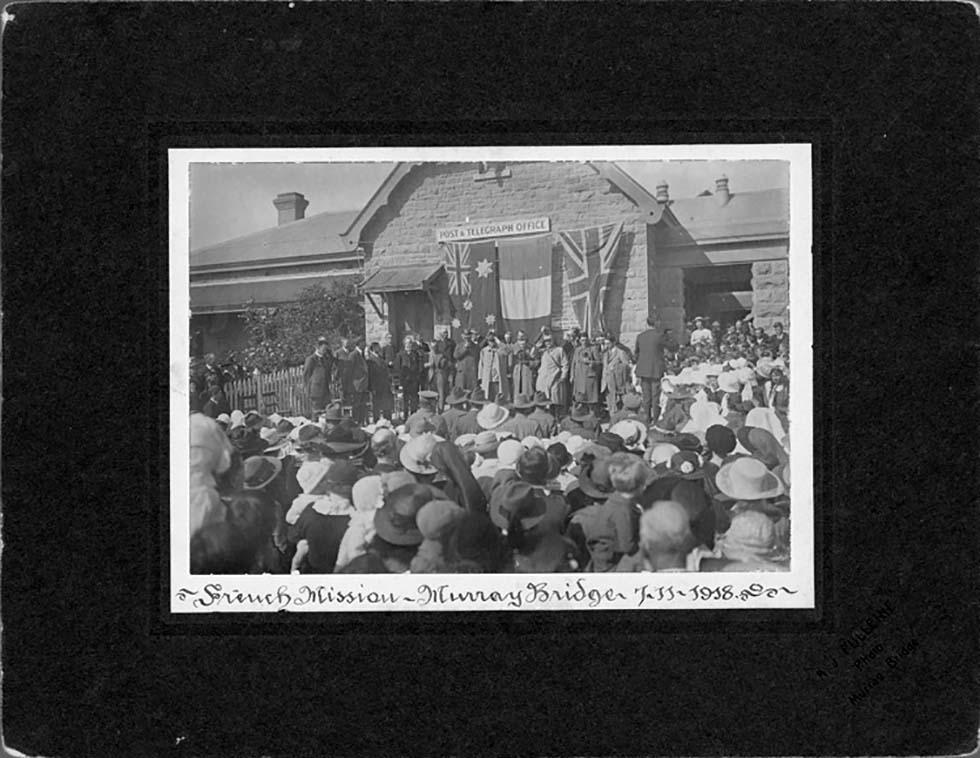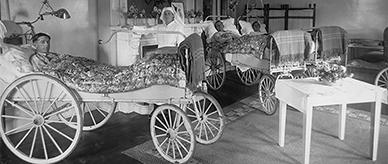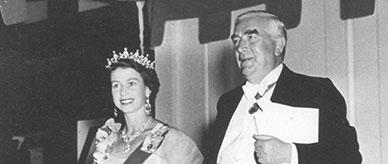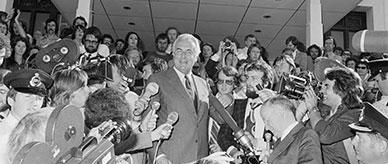


About this record
This black-and-white copy of a sepia-toned photograph shows the small South Australian town of Murray Bridge welcoming the French mission only days before the signing of the Armistice to end the First World War. Members of the mission are assembled in front of the town's post and telegraph office, which is decked with the Australian, French and British flags, displayed with equal prominence. The handwritten words 'French Mission – Murray Bridge 7–11–1918' appear under the photograph, which is mounted on card and bears the stamp of the photographer AJ Pulleine in the bottom right corner.
Educational value
- This photograph shows members of a French delegation being welcomed by the people of Murray Bridge during a three-month goodwill visit to Australia which began in Sydney in September 1918. The delegation, at the invitation of the Australian Government, attended public functions and visited commercial and industrial sites across the country. The tour was led by distinguished war veteran General Paul Pau (1848–1932), and aimed to foster national and commercial relations and acknowledge the contribution of both nations to the war effort.
- The welcoming of the French mission to Murray Bridge was a major event for the town, which as a centre of primary and secondary industry on the Murray River had much to interest the visitors. On their arrival from Melbourne, the delegation was treated to a performance of the French national anthem, La Marseillaise, by the town's schoolchildren, who were granted a day's holiday as reward for their efforts. The envoys later boarded a train for Adelaide, where banners greeted them with ‘Vive la France’ and 'Entente Cordiale'.
- Although the visit was a success, Australian authorities – unschooled in the finer points of French diplomacy – struggled to, as Acting Prime Minister RJ Ferguson put it, ‘hold one’s own in the exchange of civilities with a French Mission well versed in the ar'. In a parting note sent to the Australian Government on 21 December 1918, General Pau spoke of the 'undying friendship which we found to exist' among 'your gallant soldiers' and 'the charming people of Australia'.
- Before the delegation's return to France in December 1918, the Australian Government presented each envoy with a wooden casket containing a souvenir album of memorabilia and photographs of the visit. Along with the photograph from Murray Bridge the visitors received written and photographic records of parades, receptions and other events in Sydney, Richmond, Newcastle, Brisbane, Melbourne, Hobart, Adelaide, Perth and Broken Hill.
- The people assembled for this photograph – many of whom would have had relatives in the armed forces – would have been aware that the Great War was about to end. The Armistice was signed four days later, at 11am on 11 November 1918. In signing, Germany agreed to cease fighting, withdraw its forces and surrender its fleet and heavy guns. First commemorated as Armistice Day, the event is now observed in Britain and Australia as Remembrance Day, in honour of those who lost their lives in the First World War.
- Prime Minister William 'Billy' Hughes and Joseph Cook, Minister for the Navy, were not in Australia on the first Armistice Day, having left for London in April 1918 to attend Imperial War Cabinet meetings which ended in August. After the meetings Hughes stayed in England to negotiate the sale of 'copper, glycerine, tallow, butter, wheat, hides, leather, meat and rabbits'. He later attended the Peace Conference in Paris from January to June 1919.
Acknowledgments
Learning resource text © Education Services Australia Limited and the National Archives of Australia 2010.
Related themes
Need help with your research?
Learn how to interpret primary sources, use our collection and more.



